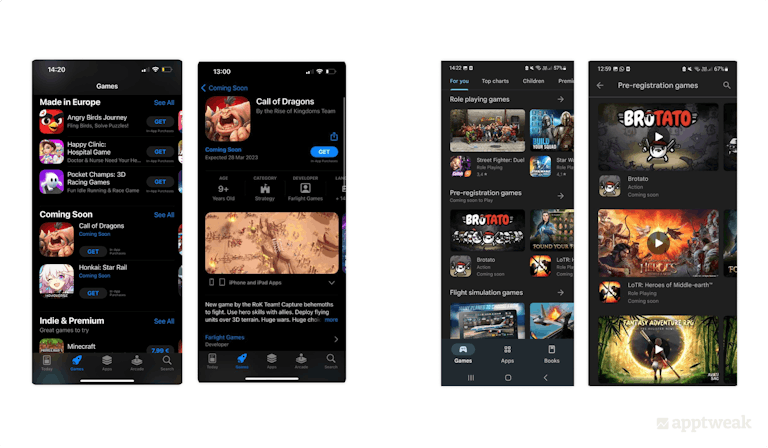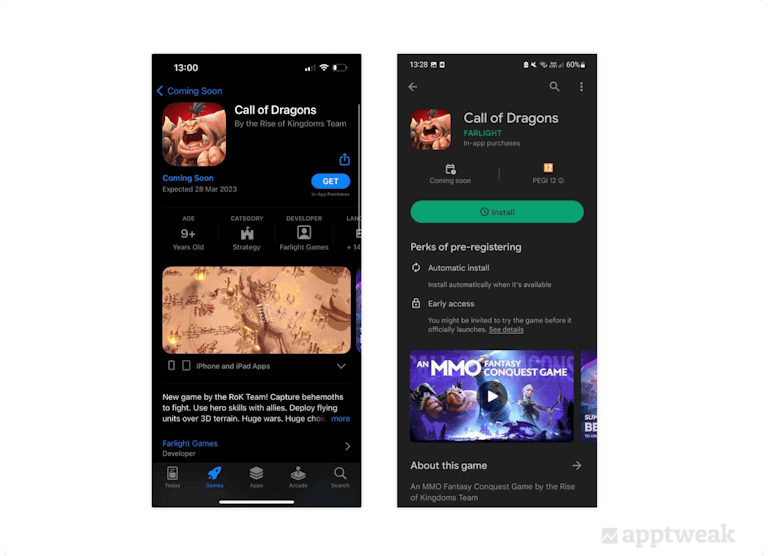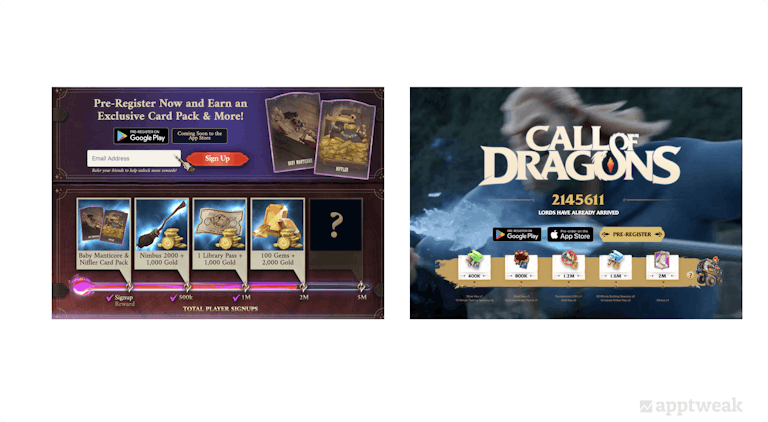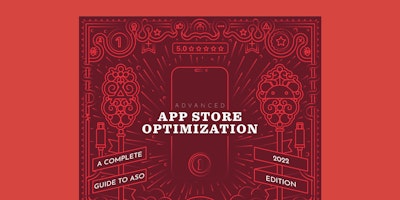
ASO Pre-Launch Strategy: Why & How to Get Started
Even before your app is on the app stores, several elements can be leveraged to maximize the impact of your launch. You’d already need to define your ASO strategy and take some important steps to effectively prepare your app for its launch on Google Play and the App Store.
So, if you’re still in the process of developing your app and are not sure how to get started, we’ve got you covered! Just read on to learn what steps you can take to define your ASO pre-launch strategy.
Soft launch: An essential step to set your app for success
An app soft launch consists of releasing a first version of your app to a limited number of users in a specific region before it is released more widely. This helps assess how your app is performing in a live environment and identify areas of improvements in terms of your product and ASO.
Soft launching also helps you minimize some risks associated with launching a new product. A soft launch can be summed up as letting users take your app prototype for a test drive and observe their behavior.
Benefits of soft launching your app
App soft launches are a safe way to test your app’s performance in the market and gather insightful audience reaction. Here are some advantages of soft launching your app:
- Soft launching your app helps you gather data and assess your app performance. It helps you identify the areas of improvement and vital iterations needed, going from your app monetization model to your app onboarding process, passing by your app product page.
- When it comes to ASO, it helps you check if your app product page is optimized. When you soft launch your app, Google and Apple’s algorithms start indexing your keywords and positioning your app on these. This can already give you an idea of which keywords are performing best and which ones aren’t. Moreover, it helps you understand which features are the most or least appealing to users, and thus helps you determine what to focus on. Thanks to this, you will not only be able to better optimize your metadata when the time comes to officially release it but also optimize your creative assets by putting the emphasis on the elements that convert store visitors better.
- Through a soft launch, users help you identify bugs in the user experience and helps you understand which monetization strategy would be the most effective one. Overall, soft launching your app helps you determine if your app is ready for the market, avoid surprises, and set your app for success.
Prepare your ASO for soft launch
Before the soft launch, it’s key to find out what competitors are doing, determine what category is best for your app, and optimize your app initial product page. Here we’ll be focusing on the ASO-related elements to prepare your app for a successful soft launch:
1. Pick the best category for your app
Determining which category is best suited for your app is important. This will define the semantic group of keywords your app will be indexed for, as well as for which apps your app will show in the similar apps section.
To pick the best category for your app, the first step is to analyze and familiarize yourself with the specific categories by looking at their year-over-year growth, their level of competitiveness, and the apps ranking at the top to set expectations for your own app.
Once you’ve narrowed down your choice, the next step would be to look at your app’s main competitors and the category they have picked. Your competitor’s category will usually be a category that suits your app.
Discover the best category for your app or game
2. Optimize your app store page
A soft launch is the phase where you get to test all the visuals and the metadata of your product page. The algorithms in the app stores are very receptive to your metadata and creative assets, so optimizing them is a vital part of your user acquisition strategy.
- Spying on your future competitors’ app product page and ASO strategy can help you find hints and inspiration to prepare your app’s product page. It gives you an initial idea of which keywords are interesting to target in the metadata, which features are the most appealing to your future potential users through their reviews, and what the best practices or trends are when it comes to creative assets for your type of app.
Your metadata and creative assets will keep changing and be improved after the soft launch. Still, it’s important to have them already optimized before the hard launch to maximize your initial conversion and take advantage of the initial boost in ranking you get from the store algorithms.
- If you’re planning to launch your app in multiple languages, make sure to localize your app product page. Users like it better when the product page of an app is in their native language. This makes them feel as if the app was made for them.
3. Pick the right markets for your app soft launch
The soft launch is limited to a small set of countries that will be picked depending on the markets where you are planning to officially hard launch your app as well as the nature of your app. The key is to pick smaller markets that have, overall, a similar language and culture to that of your target market for the hard launch.
For example, if you plan to release your app in a major market like the US, it’s recommended to soft launch in an English-speaking markets like Canada, New Zealand, or Australia. In fact, these countries are the most popular when it comes to soft launch for both the app stores because of their language and similarities in user interactions with the app.
However, it’s becoming more and more expensive to soft launch in these markets. So, new countries are becoming more popular for soft launch, such as Sweden, Netherlands, or Finland. In general, some of the top countries for mobile games soft launch are Brazil, Russia, Saudi Arabia, and Egypt.
4. Create hype for your app before the hard launch
Apple and Google have introduced features to help developers increase awareness and hype around the launch of their new apps within the app stores. Still, you have to utilize this alongside other platforms, such as social media, influencers, and your app website to maximize your app’s initial launch reach.
Put your app up for in pre-order or pre-registration
New apps can be now made available for pre-order on the App Store (up to 180 days prior to release date) and pre-registration on Google Play (up to 90 days prior to release date). This allows developers to publish their store listing before the official launch and build excitement and awareness for the new apps and games. This, in turn, helps secure your first downloads.
According to a study conducted by medium.com, “Developers who run a pre-registration campaign often see a large increase in day one and day seven retention.”

Pre-order or pre-register availability can boost app visibility and downloads on the day of the launch. High download velocity in the initial weeks improves organic performance and keyword ranking.
During pre-order, users will visit your store listing to register, despite not being able to download the app.
Thus, your store listing will be the main element to convince potential users to sign up for pre-order/registration.

To optimize your initial app product page, make sure:
- Ensure your screenshots and video are high-quality, appealing, and articulate your app’s value.
- Target high search volume, relevant keywords in the index text fields.
- Localize your app page for the different languages and cultures to bring the right audience to your app.
Pre-registered users will receive a notification on the launch date to download the app.
On Apple, registered users will have the app automatically downloaded along with a notification. On Google Play, only eligible devices will be able to have the app/game auto-installed.
Offer rewards and incentives
In the pre-launch phase, developers can offer rewards or incentives to encourage people to pre-order/register for their app or game. The rewards consist of in-app products. Offering rewards helps increase your app downloads, conversion, and retentio
Since this feature was released, many games have already leveraged it to convince potential users to sign up for pre-order/registration:
- Peridot from Niantic offers an exclusive party hat cosmetic for the dots to users who pre-register and play within the first two weeks.
- Call of Dragons from FARLIGHT and Harry Potter: Magic Awakened from Warner Bros offer different awards to users who pre-register depending on the total number of users that registered.
- DC Heroes & Villains from Ludia Inc. offers a set of exclusive items for every pre-registered user.

Crash Bandicoot: On the Run!, a running game from King, is another successful example. It offered users, who pre-ordered/registered for the game, a special Blue Hyena Skin for Crash to encourage them to sign up. The game got more than 8.1 million downloads on day 1 of the launch.

Other Google Play pre-launch practices
Leverage these Google Play best practices to boost pre-registered users and interest in your app or game:
- Custom store listings to target pre-registered users specifically. This enables you to tailor your app’s assets and message for a specific country during the pre-launch phase.
- App campaigns for pre-registration to help generate an early download base before a launch.
- Google Play promotional content (earlier LiveOps) for pre-registration announcements to showcase new content, game demo, or inform on milestone rewards. This boosts the excitement about your app/game and keeps pre-registered users engaged throughout the pre-launch phase.
- Google Play Instant (for games specifically): Allows users to use your app or game without installing it. This increases engagement before the app launch and downloads after the launch. It also secures quality traffic less likely to uninstall your app/game after trying it.
App soft launch checklist
Building the perfect app and a well-optimized store listing takes time and a lot of testing. Therefore, soft launch is a crucial step to set your app up for success. To wrap up, let’s recap the most important factors to consider when soft launching your app:
- Pick the best category for your app. Analyze the specific categories you’re considering for your app and consider which category (categories) your competitors are picking.
- Test the visuals and metadata of your app product page by spying on your future competitors. It can give you an idea on which keywords are interesting to target in your app metadata.
- Choose smaller markets with similar language and culture to your target for the hard launch.
- Run pre-registration campaigns or pre-orders to generate buzz before the hard launch.
- Offer in-app rewards or incentives to encourage users to pre-order/register to increase your app downloads and conversion.



 Georgia Shepherd
Georgia Shepherd

 Micah Motta
Micah Motta

 Oriane Ineza
Oriane Ineza

 Lina Danilchik
Lina Danilchik

 Alexandra De Clerck
Alexandra De Clerck

 Simon Thillay
Simon Thillay